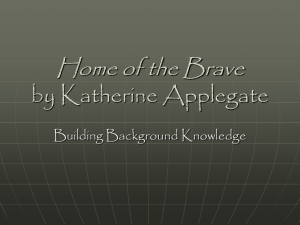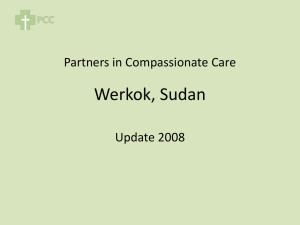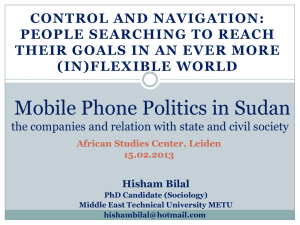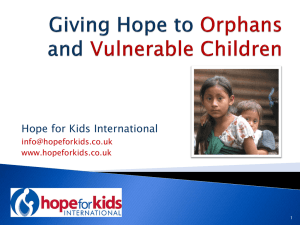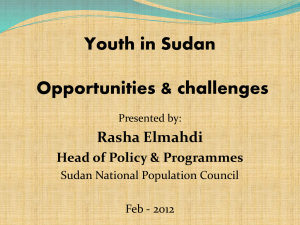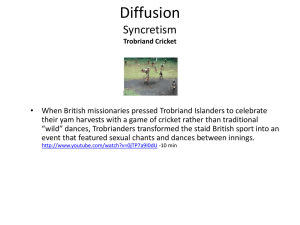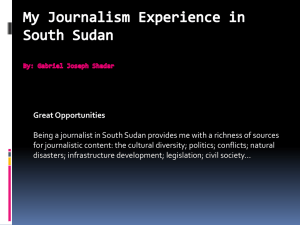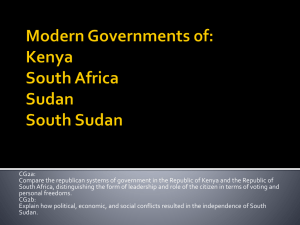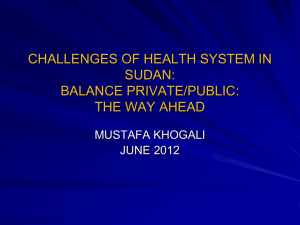150218 - FSLC meeting(Final)
advertisement
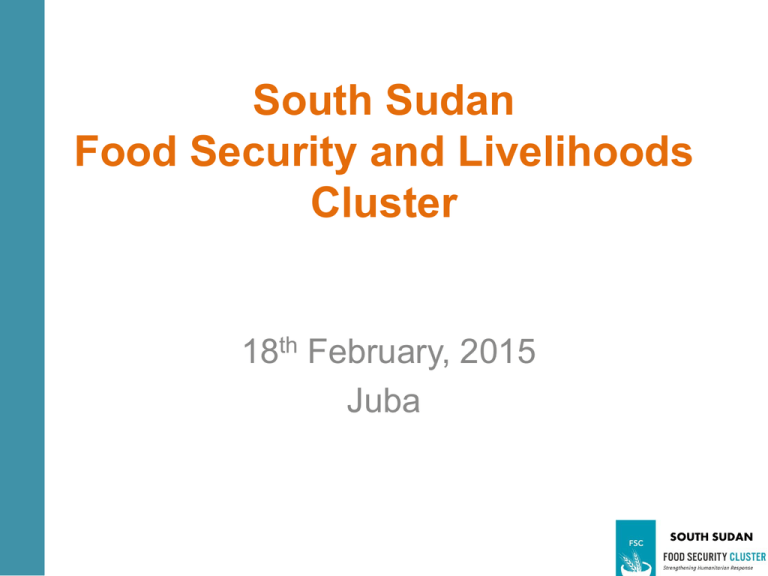
South Sudan Food Security and Livelihoods Cluster 18th February, 2015 Juba SOUTH SUDAN AGENDA • Monitoring framework /plan for FSL cluster-2015 • Socio Economic reintegration of children released from the Cobra Faction in the GPAA (UNICEF) • Emergency Market Mapping Analysis (Mercy Corps) • Saving lives and building Futures (MAG) • Information Management tools for 2015. • AOB – Update on ICWG Visit to Bentiu – Working Group Updates SOUTH SUDAN Monitoring framework /plan for FSL cluster-2015 Haile Aberra, M & R Specialist FSL Cluster 18 February, 2015 SOUTH SUDAN Introduction • Monitoring and reporting the collective results of a large-scale, multi-agency /cluster intervention is challenging • M & R framework, results and log-frame, Objectives, outcomes and outputs; Standard and custom indicators • Mutually reinforcing and complementary, and avoid overlapping demands • Knowledge sharing and lessons learnt, to support improved project implementation and future decision-making as well as for intercluster information sharing SOUTH SUDAN Introduction . . . • Reporting-not just outputs and outcomes, but joint analysis to determine progress towards meeting strategic and cluster objectives and answer: “have the FSL cluster partners done what they committed to do in the Crisis Response Plan / Cluster Response Plan, and if not what should be done to address these shortcomings”. SOUTH SUDAN Scope & Level of monitoring & reporting Planning Monitoring and Reporting Strategic Response Planning -CRP Strategic level monitoring, Outcome and Output results Cluster planning Cluster level monitoring Projects planning Project level monitoring AGGREGATION SOUTH SUDAN Monitoring and Reporting Framework The monitoring and reporting framework will broadly define what will be monitored and when, who is responsible for monitoring and analysis, how the monitoring information will be reported, what key actions will be taken and what resources are necessary for successfully applying the framework. SOUTH SUDAN M & R Plan for 2015 • CHF only 36 projects / FSL -96 organizations • 6-10 States, ---- counties and ---- payams • Methodology: consultation with partner organizations, review of documents / reports, random selection of projects ensuring representative types of organizations, size of funds, risks levels, SOUTH SUDAN M & R Plan for 2015…. • Intensive field monitoring, assistance required from every member of the cluster; at least one-two organizations per State, at least one monitoring field visit per Month • Discussions with project beneficiaries, government authorities, implementing partners and other stakeholders, cluster area coordinators • Aggregation at the cluster level [results vis-àvis strategy] • The importance of qualitative data SOUTH SUDAN • Thank you! Questions? Haile.Aberra@fao.org +211921582232 SOUTH SUDAN Socio Economic reintegration of children released from the Cobra Faction in the GPAA (UNICEF) SOUTH SUDAN Emergency Market Mapping Analysis (Mercy Corps) SOUTH SUDAN Emergency Market Mapping and Analysis (EMMA): Livestock Off-take and Sorghum Market Systems Abiemnhom County, Unity, South Sudan February 2015 Mohamed Ali Mercy Corps Market and Livelihoods Advisor mali@ss.mercycorps.org CRITICAL MARKET SYSTEMS • Sorghum • Cattle off-take • Goat and Sheep off-take EMMA Purpose: understand current and potential markets system & effects of conflict on market functionality Income Gap Analysis • Household Income: pre crisis: 580-1010 SSP (103-180 USD). • Post crisis: drop 30-42% drop in monthly incomes • Pre crisis: sorghum production and livestock rearing. • Post crisis: households (85%) reported disruptions in the first planting season (displacement), and a 40% loss of second season crop production due to flooding Income Gap Analysis • Additionally, loss of livestock due to theft or cattle raids. • Pre crisis, hh 35-40% depended on markets of their and 25-30% from their own production and 5-25% from other sources. • Pre crisis livestock sales contributed 30-35% of financial needs. Post crisis livestock were lost, moved further away. • Income sources not diverse: limited to Ag/livestock supplemented by trading Sorghum Market Networks, North Unity State Southern Unity State and part of the greater Upper Nile is classified as a sorghum deficit zone that largely depends on a healthy market supply Depend: food aid, suplus from neighboring counties and imports: Imports from Sudan affected by boarder closure FEWSNET Trade networks after crisis A number of disruptions have occurred: 1. The closure of the Sudanese border. 2. Flooding in 2014. 3. The current conflict 3. resulted The current conflict resulted in the closure of in the closure trade routes and reluctance among the of trade routes and transporters reluctance among the transporters Sorghum Baseline Sorghum after crisis Response Options Response Option Advantages Disadvantages Feasibility and Timing Target business support and strengthening of inkages between local markets and end/hub market actors: financial and infrastructure nvestment such as cash transfers and capacity development. A good way of laying a foundation for a longerterm market-based approach in access to inputs, services and infrastructure. Low impact on household incomes. Need to address other causes of supply constraints such as conflict in order to get returns. Feasibility – medium. Food voucher and unconditional cash transfers to the vulnerable households. This is linked to business support to market actors to reduce risk of inflation (see option above). Households will be able to access essential commodities while retailers will be guaranteed demand. The support to the market actors will ensure that market is functioning well and cash will not result in increased prices. The traders will need to stock adequate quantities of essential commodities – capacity of market to replenish may be limited until larger traders and transporters who fled return. Cash injection can lead to inflation in already disrupted markets. Feasibility – high. Can be implemented within good time. It is a quick short-term intervention. Address supply constraints ncluding addressing nfrastructure, informal ees and taxes, and opening of the border. Holds key to addressing the persistent supply chain deficits in sorghum. Requires large investment and political goodwill both locally (within the counties) and nationally (in South Sudan and Sudan). Low feasibility. Emergency vaccination and animal treatment. This should be conducted in collaboration with existing market actors. Prevent and mitigate risk of disease outbreaks following the disruption of livestock migration. Risk of further undermining the nascent private sector service providers if the program is not targeted well or is designed without private sector involvement. Short term intervention, but can build foundation for the development of market led animal health and input services. Provide business support & facilitate linkages among ivestock market actors in the local and end markets while enhancing bridging capital across the value chain to build on success stories where conflicting communities are bridging the ethnic divisions to More feasible once the conflict situation subsides High impact. LEGS recommends that animals be dewormed and vaccinated regularly, preferably before the dry season/ drought conditions set in. Ease movement of livestock between markets, thus increasing the trade volume and off takes. Needs investment in infrastructure and addressing of policy and legal issues such as informal fees and taxes and proliferation of checkpoints. Slow, challenging and risk perceived as parallel governance system that could be counterproductive. Medium to long term with low feasibility especially for revising informal fees, taxes and checkpoints. Thank you. Mohamed Ali Mercy Corps Market and Livelihoods Advisor mali@ss.mercycorps.org Saving lives and building Futures (MAG) SOUTH SUDAN SOUTH SUDAN Every day, nine people are killed or suffer horrific injuries because of landmines and other explosive weapons. SOUTH SUDAN Impact in 2014 918,829m2 of safe land returned 630 hazardous areas cleared 391 new hazardous areas identified 26,156 items of ERW destroyed 1,528 mine risk education sessions provided to 41,187 beneficiaries 7 out of 10 States benefited from MAG activities, including Jonglei and Unity SOUTH SUDAN Landmines and ERW South Sudan SOUTH SUDAN SOUTH SUDAN SOUTH SUDAN SOUTH SUDAN EFFECTS OF CONTAMINATION SOUTH SUDAN DEATH AND INJURY SOUTH SUDAN PREVENTING ACCESS TO LAND FOR AGRICULTURE AND INFRASTRUCTURE DEVELOPMENT PREVENTING MAXIMUM PRODUCTIVITY FROM LAND USE DAMAGE TO ASSETS, INCLUDING LIVESTOCK BLOCKING ACCESS TO RESOURCES AND SERVICES RESTRICTING FREEDOM OF MOVEMENT AND SAFE HUMANITARIAN ACCESS PSYCHOLOGICAL IMPACT DUE TO FEELING OF INSECURITY AND CONSTANT THREAT TO LOVED ONES SOUTH SUDAN MAG can contribute to FSL activities SOUTH SUDAN ● Joint assessment missions and information sharing to support response design and preparedness ● Contamination assessment and non-technical survey - pre-FSL activities - compound search, operational areas assessment - local communities and conflict affected areas ● Clearance of land for agriculture, infrastructure development, and humanitarian access - Minefields - Battle areas - Hazardous areas ● Explosive remnants removal and destruction ● Rapid response (assessment, clearance, MRE) ● Coordinated response with the wider mine action sector through the Mine Action Sub-Cluster: UNMAS, NPA, DCA, DDG ● Mine Risk Education to FSL staff at country base and field level ● Mine Risk Education to at-risk communities, displaced people, in public school and health centers SOUTH SUDAN MAG Presence as of February 2015 SOUTH SUDAN Forof your safety and the735 safety of your As January 2015, hazards beneficiaries, please report any items to MAG The support ofinallSouth is required to free remain open Sudan with and landmines UNMAS South Sudan and ERW many more from waiting to be identified SOUTH SUDAN Please report any items to MAG and UNMAS at cd.southsudan@maginternational.org report@unmas.org or call 0920001055 SOUTH SUDAN Thank You SOUTH SUDAN Information Management tools for 2015. • The online tool. – http://imtool.foodsecuritycluster.net – Training Next week. • 5 Ws to be submitted to OCHA every month. SOUTH SUDAN IRNAs in 2015 1. Kandak, Ayod 2. Nynapol, Ayod 3. Kotdalok, Ayod 4. Kurwai, Canal/ Pigi 5. Menime, Ayod 6. Wai, Ayod 7. Koch, Unity What have we done so far? What plans do we have? Send your information to us by Friday, 20th February 2015 SOUTH SUDAN AOB – Update on ICWG Visit to Bentiu – Working Group Updates SOUTH SUDAN
